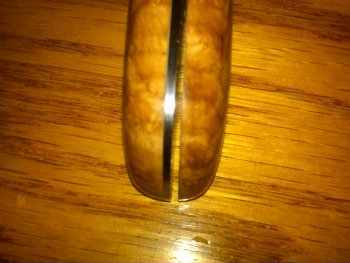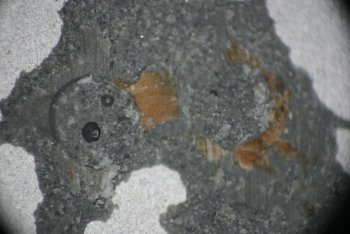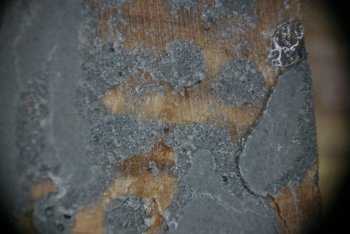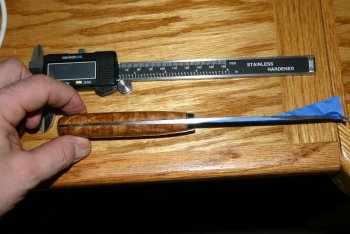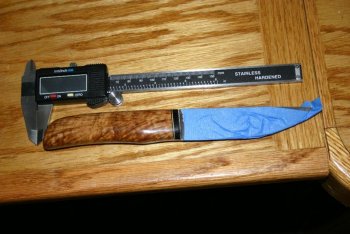Hi All,
So about 9 months ago I was tasked with making a custom carving knife. The client wanted a lower cost unit, just a full tang with sharp blade and scales, no pins, no bolsters, no guard. He did want some nicer looking scales and picked out some oak that was done by WSSI.
About two months ago the thing comes back into the shop, both scales peeling off. Closer inspection showed the scales were pulling up off the steel. The oak just pulled away from the steel. Epoxy was left on both the blade and wood. When my scales go on a knife the steel gets etched, scrubbed, and degreased before. Wood gets sanded down with a fresh sharp belt, and wiped down with acetone before gluing. I keep everything spotless clean. Only fresh epoxy, and DO NOT touch the surfaces being glued together. No oil, or contamination.
Anyway, I pop the scales off the knife. I clean the blade and bring the blade to my buddies auto body shop, where the whole tang gets sand blasted with crushed glass. Nice rough finish on the tang. It gets cleaned and wrapped up in paper and put away. Scales were bowed slightly (Obviously, the stabilized wood moved!), so I let them sit for a week or so and sanded them flat. I took a 400K RPM grinder and drilled up the mating surface with a small round burr. There were holes every 1/16th of an inch over the whole inside surface of the scales. Not a roughened surface, actual holes. Everything was cleaned again. Applied epoxy to the scales until the holes were filled, and applied epoxy to the tang. Mated everything together and used some string to apply light pressure. After the epoxy cured the extra epoxy was removed and the handle was refinished. There is absolutely no doubt in my mind this epoxy job will last forever!
Well, last night I get a call. One of the scales is lifting off the knife again.
Couple of things come to mind. First was I was not completely happy with the WSSI job on the wood. It just didn't have as much resin in it as some of the other blocks from the same batch, and nowhere near the resin in the stuff from AKS or other vendors. Over a three inch length, this wood curled up about 1/16th of an inch. Seems too much for stabilized wood. Of course, this knife doesn't have bolsters or a guard. This was intended as a low cost knife, and this 'extra' was too expensive. Hindsight makes me wonder if the extra metal would have helped strengthen the whole thing and prevented this.
Also, This guy's carving style is pretty forceful. He doesn't break blades, but puts a lot of pressure on the knife and wood. I spent some time watching him carve before we designed the blade. He knows how to handle a knife, but he does work them hard. No doubt this knife gets used harder than any of my other knives. The blade has taken the work just fine, and he loves how sharp it stays. However the scales just aren't sticking.
I'm really at a loss here. I don't know if it's the wood, the lack of bolsters, the stabilization, the hard use, or a perfect storm of all of these. Currently, I'm thinking the solution is a new blade with a much thicker tang to take the force. This current blade is about .140 thick, but it is tapered to the back of the handle, so it's possible it's flexing too much in use.
I'm just at a loss. I'm hoping you all may have some nuggets of wisdom here.
Thanks,
Dan
So about 9 months ago I was tasked with making a custom carving knife. The client wanted a lower cost unit, just a full tang with sharp blade and scales, no pins, no bolsters, no guard. He did want some nicer looking scales and picked out some oak that was done by WSSI.
About two months ago the thing comes back into the shop, both scales peeling off. Closer inspection showed the scales were pulling up off the steel. The oak just pulled away from the steel. Epoxy was left on both the blade and wood. When my scales go on a knife the steel gets etched, scrubbed, and degreased before. Wood gets sanded down with a fresh sharp belt, and wiped down with acetone before gluing. I keep everything spotless clean. Only fresh epoxy, and DO NOT touch the surfaces being glued together. No oil, or contamination.
Anyway, I pop the scales off the knife. I clean the blade and bring the blade to my buddies auto body shop, where the whole tang gets sand blasted with crushed glass. Nice rough finish on the tang. It gets cleaned and wrapped up in paper and put away. Scales were bowed slightly (Obviously, the stabilized wood moved!), so I let them sit for a week or so and sanded them flat. I took a 400K RPM grinder and drilled up the mating surface with a small round burr. There were holes every 1/16th of an inch over the whole inside surface of the scales. Not a roughened surface, actual holes. Everything was cleaned again. Applied epoxy to the scales until the holes were filled, and applied epoxy to the tang. Mated everything together and used some string to apply light pressure. After the epoxy cured the extra epoxy was removed and the handle was refinished. There is absolutely no doubt in my mind this epoxy job will last forever!
Well, last night I get a call. One of the scales is lifting off the knife again.
Couple of things come to mind. First was I was not completely happy with the WSSI job on the wood. It just didn't have as much resin in it as some of the other blocks from the same batch, and nowhere near the resin in the stuff from AKS or other vendors. Over a three inch length, this wood curled up about 1/16th of an inch. Seems too much for stabilized wood. Of course, this knife doesn't have bolsters or a guard. This was intended as a low cost knife, and this 'extra' was too expensive. Hindsight makes me wonder if the extra metal would have helped strengthen the whole thing and prevented this.
Also, This guy's carving style is pretty forceful. He doesn't break blades, but puts a lot of pressure on the knife and wood. I spent some time watching him carve before we designed the blade. He knows how to handle a knife, but he does work them hard. No doubt this knife gets used harder than any of my other knives. The blade has taken the work just fine, and he loves how sharp it stays. However the scales just aren't sticking.
I'm really at a loss here. I don't know if it's the wood, the lack of bolsters, the stabilization, the hard use, or a perfect storm of all of these. Currently, I'm thinking the solution is a new blade with a much thicker tang to take the force. This current blade is about .140 thick, but it is tapered to the back of the handle, so it's possible it's flexing too much in use.
I'm just at a loss. I'm hoping you all may have some nuggets of wisdom here.
Thanks,
Dan


